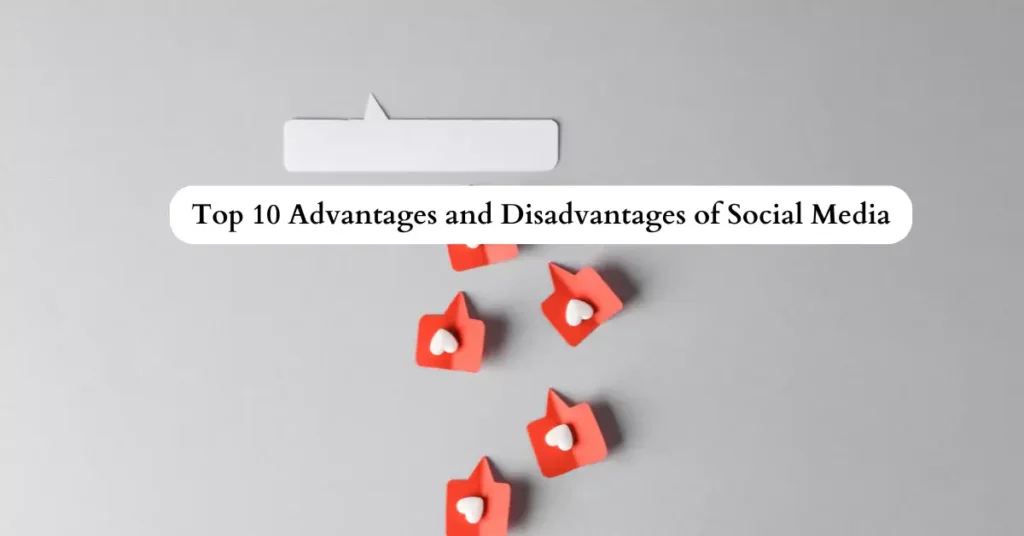Social media has become a major part of our daily lives, connecting people from all corners of the world with just a few clicks. Whether it’s Facebook, Instagram, Twitter, or TikTok, these platforms have transformed how we communicate, share information, and even do business. But like everything else, social media has its own set of advantages and disadvantages. On the bright side, it allows us to stay in touch with friends and family, discover new trends, and create communities. However, it also has downsides like privacy concerns, cyberbullying, and addiction. In this blog, we’ll explore the top 10 advantages and disadvantages of social media, helping you understand both the positive and negative impacts it can have on our lives. Whether you’re a social media enthusiast or a casual user, this insight will help you navigate the digital landscape more wisely.
What are the top 10 advantages of using social media for businesses?
Social media has become a powerful tool for businesses, offering a range of benefits that can significantly boost growth and success. Here are the top 10 advantages of using social media for businesses:
Increased Brand Awareness: Social media platforms like Facebook, Instagram, and Twitter allow businesses to reach a wider audience, increasing brand visibility and recognition.
Cost-Effective Marketing: Creating profiles and posting content on social media is free. Even paid advertising on these platforms is generally cheaper compared to traditional advertising methods, making it a cost-effective marketing strategy.
Improved Customer Engagement: Social media provides a direct line of communication between businesses and customers. Companies can engage with their audience through comments, messages, and posts, building stronger relationships and customer loyalty.
Enhanced Customer Insights: Social media analytics tools help businesses understand their audience better by providing data on customer behavior, preferences, and demographics. This information is invaluable for tailoring marketing strategies.
Increased Website Traffic: Sharing content and links on social media can drive traffic to a business’s website, increasing the chances of converting visitors into customers.
Higher Conversion Rates: Businesses that interact regularly with their audience on social media often see higher conversion rates. Positive interactions build trust, which can lead to more sales and customer retention.
Competitive Advantage: Staying active on social media allows businesses to keep an eye on competitors, learn from their strategies, and stay ahead in the market.
Better Customer Service: Social media offers a platform for customers to voice their concerns and for businesses to respond quickly and effectively, enhancing customer satisfaction.
Content Sharing and Virality: Social media makes it easy for content to be shared quickly, potentially going viral and reaching a massive audience, which can greatly enhance brand exposure.
Boosted SEO Rankings: An active social media presence can improve search engine rankings. Search engines consider social signals as a factor in determining the relevance and authority of a business’s website.
What are the Top 10 Disadvantages of Social Media?
Social Media has revolutionized how we connect and interact, but it’s not without its drawbacks. Here are the top 10 disadvantages:
Cyberbullying: Online harassment and bullying can have serious emotional and psychological impacts on individuals, especially young users.
Privacy Concerns: Personal information shared online can be misused or exploited, leading to identity theft or invasion of privacy.
Fake News: Misinformation spreads rapidly on social media, influencing public opinion and creating confusion.
Addiction: Constant notifications and updates can lead to addictive behaviors, affecting productivity and mental well-being.
Health Issues: Excessive use of social media can contribute to issues like eye strain, poor posture, and disrupted sleep patterns.
Comparison Anxiety: Continuous exposure to idealized images and lifestyles can foster feelings of inadequacy and low self-esteem.
Impact on Relationships: Over-reliance on social media for communication may diminish face-to-face interactions and intimacy.
Distraction: Social media can be a significant distraction, affecting academic or professional performance.
Echo Chambers: Users often engage with like-minded individuals, reinforcing biases and limiting exposure to diverse viewpoints.
Time Consumption: Hours spent scrolling through feeds can detract from real-life experiences and personal development.
While social media offers numerous benefits, it’s crucial to be aware of these disadvantages. Balancing usage, being mindful of privacy settings, and critically evaluating information can help mitigate these challenges. By understanding both the positives and negatives, users can make informed choices about their online presence and well-being.
How does it help in brand visibility and awareness?
Social media plays a crucial role in boosting brand visibility and awareness. By creating profiles on platforms like Facebook, Instagram, and Twitter, brands can reach a large and diverse audience. Regular posts and engaging content keep the brand in the minds of users, making them more likely to remember and recognize it. Social media also allows brands to interact directly with their audience through comments, messages, and likes, building a strong connection and loyalty.
Additionally, sharing photos, videos, and stories helps showcase the brand’s personality and values, making it more relatable and attractive. Paid advertisements on these platforms can target specific groups, ensuring that the brand reaches potential customers effectively. Hashtags and trending topics can further enhance visibility by connecting the brand with popular conversations. Overall, social media is a powerful tool for brands to increase their presence and build awareness in a highly competitive market.
What are the benefits of social media marketing?
Social media marketing has become a powerful tool for businesses of all sizes. One of the key benefits is increased brand awareness. By creating engaging content, businesses can reach a large audience quickly and effectively. Social media platforms like Facebook, Instagram, and Twitter allow businesses to interact directly with customers, building stronger relationships and customer loyalty.
Another advantage is cost-effectiveness. Social media marketing is often cheaper than traditional advertising methods, making it accessible for small businesses with limited budgets. Additionally, targeted advertising features enable businesses to reach specific audiences based on demographics, interests, and behaviors, ensuring that marketing efforts are more effective.
Social media also provides valuable insights through analytics tools. Businesses can track engagement, monitor trends, and measure the success of their campaigns in real-time. This data helps in making informed decisions and optimizing strategies for better results.
How does social media enhance customer engagement and interaction?
Social media is a powerful tool that enhances customer engagement and interaction in many ways.
- It allows businesses to connect with customers instantly. Platforms like Facebook, Instagram, and Twitter let companies share updates, promotions, and news directly with their audience. Customers can comment, like, and share these posts, creating a two-way communication channel.
- It provides a space for customers to share their experiences and feedback. When businesses respond promptly, it shows they care about customer opinions, building trust and loyalty. Third, social media campaigns, such as contests and polls, encourage active participation, making customers feel involved and valued.
- The use of direct messaging allows for personalized interactions, addressing customer queries and issues quickly. Overall, social media bridges the gap between businesses and customers, fostering a community where engagement and interaction thrive, leading to stronger relationships and improved customer satisfaction.
What are the risks associated with It’s usage for businesses?
One major risk is damage to reputation. Negative comments or reviews can spread quickly, hurting a brand’s image. Privacy issues are another concern, as sensitive company data can be exposed if accounts are hacked. Businesses also face the threat of cyber attacks, like phishing scams targeting their social media accounts. Moreover, the spread of misinformation can mislead customers and harm the company’s credibility. Employee behavior on social media can also pose a risk; inappropriate posts can reflect poorly on the business. Additionally, staying compliant with advertising regulations and data protection laws on social media platforms is crucial but challenging. Lastly, investing too much time and resources without a clear strategy can lead to poor returns on investment. Being aware of these risks helps businesses use more effectively and safely.
What are the potential negative impacts on mental health?
Social media has changed how we connect with others, but it also has potential negative impacts on mental health. One major issue is the comparison trap. When we see perfect photos and happy updates from others, it’s easy to feel inadequate or unhappy with our own lives. This can lead to feelings of low self-esteem and depression. Cyberbullying is another concern, where people face harassment and negative comments online, leading to anxiety and stress. Additionally, spending too much time on social media can cause sleep problems, as the blue light from screens affects our sleep patterns. It can also lead to addiction, where we feel the need to constantly check our phones, disrupting our daily lives and real-life interactions.
How does it affect personal privacy and data security?
Social media has a big impact on personal privacy and data security. When we use platforms like Facebook, Instagram, and Twitter, we often share personal information without realizing the risks. Social media companies collect our data, including photos, location, and even our likes and dislikes, to create detailed profiles. This information can be sold to advertisers or used for targeted ads.
Additionally, sharing too much online can make us vulnerable to hackers and identity theft. Cybercriminals can use the information we post to steal our identity or access our accounts. Privacy settings can help, but they are not foolproof.
Moreover, social media platforms have experienced data breaches where millions of users’ information has been exposed. These incidents show that our personal data is not always safe online. It’s important to be cautious about what we share and regularly update our privacy settings to protect our personal information.
What are the challenges of managing it’s content effectively?
Managing content effectively presents several challenges.
- Creating engaging content consistently can be difficult. It’s users have short attention spans, so content needs to be fresh and interesting to keep them engaged.
- Staying up-to-date with trends and platform algorithms is essential but time-consuming. Each platform has different rules and trends that can change quickly.
- Managing multiple accounts can be overwhelming, especially for businesses. It requires time, effort, and sometimes a dedicated team to maintain a consistent presence.
- Responding to comments and messages promptly is crucial for customer satisfaction but can be challenging with a large audience.
- Analyzing performance and adjusting strategies based on insights can be complex. Understanding what works and what doesn’t requires careful monitoring and analysis. Overcoming these challenges requires a clear strategy, creativity, and the right tools to streamline the process.
How can businesses mitigate the risks of crisis management?
To mitigate the risks of crisis management, businesses must adopt proactive strategies.
- Maintaining an active presence on social platforms allows companies to monitor conversations and respond swiftly to any emerging issues. This involves regularly checking mentions, comments, and direct messages.
- Having a clear policy is important. Employees should be trained on appropriate online behavior and how to handle potential crises. Guidelines should outline what can and cannot be shared publicly, ensuring consistency in brand messaging.
- Transparency plays a key role. When facing a crisis, businesses should communicate openly with their audience. Acknowledging mistakes and providing updates shows accountability and can help rebuild trust.
- Preparing a crisis management plan ahead of time is essential. This plan should outline steps to take in various scenarios, including who will be responsible for communication and how messages will be disseminated.
- Leveraging social media listening tools can provide real-time insights into consumer sentiment. These tools analyse trends and sentiment around a brand, allowing businesses to address concerns proactively.
How does this influence consumer purchasing behaviour?
Social Media wields significant influence over consumer purchasing behavior today. Platforms like Instagram, Facebook, and YouTube serve as virtual marketplaces where brands showcase products and engage directly with consumers.
- It creates awareness by exposing users to products through ads, influencer endorsements, and user-generated content. This constant exposure builds familiarity and interest.
- It shapes preferences by showcasing reviews, testimonials, and real-life product experiences shared by other users. This social proof helps consumers make informed decisions.
- It enhances accessibility by allowing users to shop directly from posts or ads, streamlining the path from interest to purchase.
- It can also lead to impulse buying due to its persuasive nature and the fear of missing out (FOMO) on trendy items.
Conclusion:
Understanding the advantages and disadvantages is essential in navigating its impact on our lives. While it facilitates global connectivity and information sharing, it also poses risks such as privacy concerns, addiction, and misinformation. Balancing its benefits with mindful usage can help mitigate negative effects like cyberbullying and comparison anxiety. By being aware of these challenges and taking proactive steps to manage them, users can harness the power of social media responsibly. Ultimately, fostering a healthy relationship with digital platforms is key to maximizing the benefits while minimizing the drawbacks in our increasingly interconnected world.
For more such content please click on- Rapid Samachar



